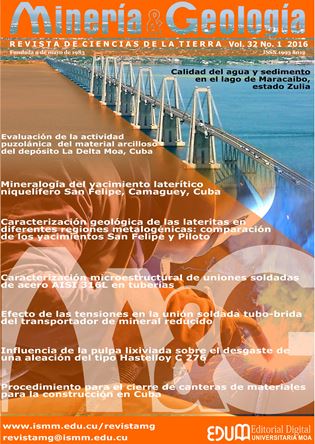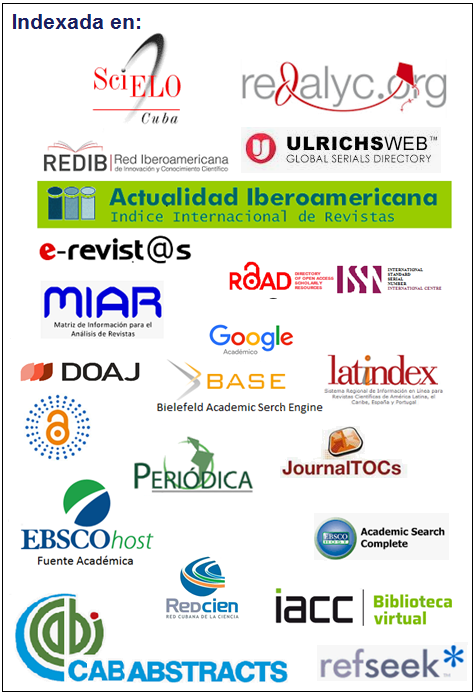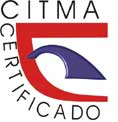Assessment on the puzzolanic activity of clayey materials in La Delta deposit
Keywords:
kaolinitic clays, calcination, La Delta ore body, pozzolans, Portland cement.Abstract
Natural clayey materials from La Delta deposit located in Moa, Holguin was characterized through the techniques of atomic absorption spectrometry, X ray diffraction, thermo-gravimetric analysis and infrared spectroscopy to determine the puzzolanic activity. The clay thermal activation was completed at 650 ºC and 750 ºC. The calcination products were characterized through the grain size analysis and the specific surface in a particle analyzer. The compression resistance of the activated material was determined in the Portland cement/calcined clay system with a 70/30 ratio. The main chemical components identified were as follow: silicon dioxide; aluminum and iron associated to the mineral phases contained in the clayey material. The material obtained is a puzzolanic material with a high reactivity. This indicates that it has potential for use as a partial replacement for cement taking into account that its resistance is 75 % higher than that of the reference product.Downloads
References
ALUJAS, A.; FERNÁNDEZ, R.; QUINTANA, R.; SCRIVENER, K. L. & MARTIRENA, F. 2015: Pozzolanic reactivity of low grade kaolinitic clays : Influence of calcination temperature and impact of calcination products on OPC hydration. Applied Clay Science 108: 94–101.
AMBROISE, J.; MARTIN-CALLE, S. & PÉRA, J. 1992: Pozzolanic behaviour of thermally activated kaolin. In: Proc. 4th Int. Conf. Fly Ash, Silica Fume, Slag and Naturals Pozzolans in Concrete. Vol. 1. ACI, Detroit, USA, p. 731–748.
BICH, C.; AMBROISE, J. & PÉRA, J. 2009: Influence of degree of dehydroxylation on the pozzolanic activity of metakaolin. Applied Clay Science 44(3): 194–200.
CASTILLO, R.; FERNÁNDEZ, R.; ANTONI, M.; SCRIVENER, K.; ALUJAS, A. & MARTIRENA, J. F. 2010: Activación de arcillas de bajo grado a altas temperaturas. Revista Ingeniería de Construcción 25(3): 329–352.
CHAKCHOUK, A.; TRIFI, L.; SAMET, B. & BOUAZIZ, S. 2009: Formulation of blended cement: Effect of process variables on clay pozzolanic activity. Construction and Building Materials 23(3): 1 365–1 373.
CYR, M.; LAWRENCE, P. & RINGOT, E. 2005: Mineral admixtures in mortars. Quantification of the physical effects of inert materials on short-term hydration. Cement and Concrete Research 35(4): 719–730.
DRITS, V. A. 2003: Structural and chemical heterogeneity of layer silicates and clay minerals. Clay Minerals 38(4): 403–432.
FERNÁNDEZ, R.; MARTIRENA, F. & SCRIVENER, K. L. 2011: The origin of the pozzolanic activity of calcined clay minerals: A comparison between kaolinite, illite and montmorillonite. Cement and Concrete Research 41(1): 113–122.
HABERT, G.; CHOUPAY, N.; ESCADEILLAS, G.; GUILLAUME, D. & MONTEL, J. M. 2009: Clay content of argillites : Influence on cement based mortars. Applied Clay Science 43(3): 322–330.
HE, C.; MAKOVICKY, E. & OSBACK, B. 1994: Thermal stability and pozzolanic activity of calcined kaolin. Applied Clay Science 9(3): 165–187.
HE, C.; OSBAECK, B. & MAKOVICKY, E. 1995: Pozzolanic reactions of six principal clay minerals: Activation, reactivity assessments and technological effects. Cement and Concrete Research 25(8): 1 691–1 702.
IGP. 2010: Arcillas caoliníticas cubanas. Estado Actual. La Habana, Cuba.
KAKALI, G.; PERRAKI, T.; TSIVILIS, S. & BADOGIANNIS, E. 2001: Thermal treatment of kaolin: The effect of mineralogy on the pozzolanic activity. Applied Clay Science 20(1): 73–80.
MARTIRENA, J.; FERNÁNDEZ, R.; ALUJAS, A.; CASTILLO, R. & SCRIVENER, K. 2011: Production of activated clays for low cost building materials in developing countries. In: 13th International Congress on the Chemistry of Cement. Madrid, España, p. 1–7.
MEUNIER, A. 2005: Clays. 2nd edition. Springer-Verlag, Berlin Heidelberg, 467 p.
MURRAY, H. H. 2000: Traditional and new applications for kaolin, smectite, and palygorskite: A general overview. Applied Clay Science 17(5): 207–221.
NJILA, T.; DÍAZ, R.; OROZCO, G. & ROJAS, L. A. 2010: Un acercamiento a las cortezas de meteorización no niquelíferas del nordeste de Cuba. Minería y Geología 26(2): 14–34.
PONS, J. & LEYVA, C. 1996: Empleo de las arcillas ferrocaoliníticas–gibbsíticas de la región de Moa en los talleres de fundición. Minería y Geología 13(3): 93–97.
PONS, J.; PÉREZ, O.; RAMÍREZ, B. & RAMÍREZ, M. 1997: Caracterización de las arcillas refractarias de la zona de Cayo Guam y su empleo en la fundición. Minería y Geología 14(3): 19–23.
SHVARZMAN, A.; KOVLER, K.; GRADER, G. S. & SHTER, G. E. 2003: The effect of dehydroxylation/amorphization degree on pozzolanic activity of kaolinite. Cement and Concrete Research 33(3): 405–416.
SOUZA, P. S. L. & DAL MOLIN, D. C. C. 2005: Viability of using calcined clays, from industrial by-products, as pozzolans of high reactivity. Cement and Concrete Research 35(10): 1 993–1 998.
TIRONI, A.; TREZZA, M. A.; SCIAN, A. N. & IRASSAR, E. F. 2012: Kaolinitic calcined clays: Factors affecting its performance as pozzolans. Construction and Building Materials 28(1): 276–281.
TIRONI, A.; TREZZA, M. A.; SCIAN, A. N. & IRASSAR, E. F. 2013: Assessment of pozzolanic activity of different calcined clays. Cement and Concrete Composites 37: 319–327.
TIRONI, A.; TREZZA, M. A.; SCIAN, A. N. & IRASSAR, E. F. 2014: Potential use of Argentine kaolinitic clays as pozzolanic material. Applied Clay Science 101: 468–476.
TODOR, D. 1976: Thermal Analysis of Minerals. 1st edition. Abacus press, Tunbridge Wells, Kent, 255 p.
YUSIHARNI, B. E. & GILKES, R. 2010: Do heated gibbsite, kaolinite and goethite rehydroxylate? In: 21 St Australian Clay Minerals Conference. Brisbane, Australia, p. 131–134.
Published
How to Cite
Issue
Section
- Authors retain copyright and guaranteeing the right magazine to be the first publication of the work as licensed under a Creative Commons Attribution-NonCommercial that allows others to share the work with an acknowledgment of the work's authorship and initial publication in this journal.
- Authors may establish separate supplemental agreements for the exclusive distribution version of the work published in the journal (eg, place it in an institutional repository or publish it in a book), with an acknowledgment of its initial publication in this journal.
- Authors are allowed and recommended to disseminate their work through the Internet (e.g., in institutional telematic archives or on their websites) before and during the submission process, which can produce interesting exchanges and increase citations of the published work. (See The effect of open access)




